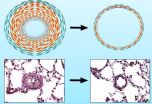(Press-News.org) A common protein plays a different role than previously thought in the opening and closing of channels that let ions flow in and out of our cells, researchers at Johns Hopkins report. Those channels are critical to life, as having the right concentrations of sodium and calcium ions in cells enables healthy brain communication, heart contraction and many other processes. The new study reveals that a form of calmodulin long thought to be dormant actually opens these channels wide. The finding is likely to bring new insight into disorders caused by faulty control of these channels, such as cardiac arrhythmias, epilepsy and Parkinson's disease, the researchers say.
A report on the finding appears in the Oct. 23 issue of the journal Cell.
In the current model, explains David Yue, M.D., Ph.D. , a professor of biomedical engineering and neuroscience at the Johns Hopkins University School of Medicine, calmodulin can do little until it binds to calcium, which changes its shape and snaps it into action. The activated calmodulin can then bind to a specialized control lever inside calcium and sodium channels, which closes the channels.
The new study revises this viewpoint by devising ways to deliver surges of calcium-free calmodulin to channels. In so doing, "it can be seen that calcium-free calmodulin is in no way dormant, but instead markedly boosts the opening of calcium and sodium channels to begin with," Yue says. When calcium binds to the "resident" calcium-free calmodulin on channels, this initial enhancement dissipates. "The two forms of calmodulin are both powerful, each imposing opposing actions that together maintain exquisite control, akin to the 'yin-yang' balance in Chinese philosophy," Yue says. "This insight into how the calmodulin-controlled lever works could ultimately help in finding treatments for a plethora of conditions that stem from faulty ion channels."
INFORMATION:
Other contributors to the paper were Paul J. Adams, Manu Ben-Johny, Ivy E. Dick and Takanari Inoue, all of The Johns Hopkins University.
This work was supported by grants from the National Institute of Neurological Disorders and Stroke (grant numbers R01NS085074 and R01NS073874), the National Heart, Lung and Blood Institute (grant number R37HL076795), the National Institute of Mental Health (grant number F31MH88109) and Parkinson Society Canada.
Read the Cell paper and listen to the PaperClip podcast. http://www.cell.com/cell/abstract/S0092-8674(14)01235-5
Study gives new view on how cells control what comes in and out
Find could be central to treating channel-related diseases such as cardiac arrhythmias, epilepsy and Parkinson's
2014-10-27
ELSE PRESS RELEASES FROM THIS DATE:
Study finds knowledge poor about stroke in Uganda
2014-10-27
CLEVELAND -- A study published in the journal International Scholarly Research Notices (ISRN) Stroke found that overall knowledge about stroke in Uganda was poor, although knowing what to do for a stroke – go to the hospital – was good.
Researchers from higher education institutions in Uganda collaborated with those from Case Western Reserve University and University Hospitals Case Medical Center to assess residents' knowledge of stroke symptoms and treatment options. To date, public perception and level of knowledge of stroke warning signs and risk factors ...
NASA's Aqua satellite eyeing Tropical Cyclone Nilofar in Arabian Sea
2014-10-27
Tropical Cyclone 04A continues to intensify and had been renamed Tropical Cyclone Nilofar when NASA's Aqua satellite passed overhead on Oct. 27.
The MODIS instrument aboard Aqua captured a visible image of Nilofar that showed a ring of strong thunderstorms around the center of circulation and bands of thunderstorms wrapping into the low-level center from the east and west.
Nilofar attained hurricane strength on Oct. 27, when maximum sustained winds were near 75 knots (86 mph/139 kph) at 1500 UTC (11 a.m. EDT). Nilofar was centered near 15.2 north latitude and 62.2 east ...
When hearing aid users listen to music, less is more, says CU-Boulder study
2014-10-27
The type of sound processing that modern hearings aids provide to make speech more understandable for wearers may also make music enjoyment more difficult, according to a new study by the University of Colorado Boulder.
The findings, published in the journal Ear and Hearing, suggest that less sophisticated hearing aids might actually be more compatible with listening to music, especially recorded music that has itself been processed to change the way it sounds.
"Hearing aids have gotten very advanced at processing sounds to make speech more understandable," said Naomi ...
Delivering a one-two punch: New drug combination shows promise in treating breast cancer
2014-10-27
The uncontrolled growth of cancer cells arises from their ability to hijack the cell's normal growth program and checkpoints. Usually after therapy, a second cancer-signaling pathway will open after the primary one shuts down — creating an ingenious escape route for the cancer cell to survive. The answer, say Case Western Reserve researchers, is to anticipate and block that back-up track by prescribing two drugs from the start. The results of the project, led by Ruth Keri, PhD, Professor and Vice Chair Department of Pharmacology, and Associate Director for Basic Research ...
UH research focuses on suicide resilience and vulnerability
2014-10-27
Religious beliefs and practices may reduce thoughts of suicide among African-American adults in stressful life events induced by racial discrimination, according to a new research study conducted at the University of Houston (UH).
"African-Americans experience an inordinate amount of psychological strain through racial discrimination, leading to depression, hopelessness and other high risk factors for suicide, but demonstrate significantly lower rates of suicide relative to European-Americans," said Rheeda Walker, associate professor and director of the Culture, Risk ...
Synapses always on the starting blocks
2014-10-27
This news release is available in German.
While neurons rapidly propagate information in their interior via electrical signals, they communicate with each other at special contact points known as the synapses. Chemical messenger substances, the neurotransmitters, are stored in vesicles at the synapses. When a synapse becomes active, some of these vesicles fuse with the cell membrane and release their contents. To ensure that valuable time is not lost, synapses always have some readily releasable vesicles on standby. With the help of high-resolution, three-dimensional ...
Satellite movie shows Tropical Storm Ana headed to British Columbia, Canada
2014-10-27
VIDEO:
This animation of NOAA's GOES-West satellite imagery from Oct. 1 -27 shows the movement of Tropical Storm Ana as it heads toward British Columbia, Canada. TRT: 00:20.
Click here for more information.
An animation of imagery from NOAA's GOES-West satellite taken over the period of Oct.19 to 26 shows the movement, intensification, weakening and movement toward British Columbia, Canada. On Oct. 27, wind warnings were posted along some coastal sections of British Columbia.
During ...
Prostate cancer, kidney disease detected in urine samples on the spot
2014-10-27
When you flush the toilet, you may be discarding microscopic warning signs about your health.
But a cunningly simple new device can stop that vital information from "going to waste."
Brigham Young University chemist Adam Woolley and his students made a device that can detect markers of kidney disease and prostate cancer in a few minutes. All you have to do is drop a sample into a tiny tube and see how far it goes.
That's because the tube is lined with DNA sequences that will latch onto disease markers and nothing else. Urine from someone with a clean bill of health ...
Lack of transcription factor FoxO1 triggers pulmonary hypertension
2014-10-27
This news release is available in German.
Pulmonary hypertension is characterised by uncontrolled division of cells in the blood vessel walls. As a result, the vessel walls become increasingly thick.
Scientists at the Max Planck Institute for Heart and Lung Research in Bad Nauheim and Giessen University have discovered that transcription factor FoxO1 regulates the division of cells and plays a key role in the development of pulmonary hypertension. The researchers were able to cure pulmonary hypertension in rats by activating FoxO1. The study findings could ...
Study documents millions in unused medical supplies in US operating rooms each year
2014-10-27
A Johns Hopkins research team reports that major hospitals across the U.S. collectively throw away at least $15 million a year in unused operating room surgical supplies that could be salvaged and used to ease critical shortages, improve surgical care and boost public health in developing countries.
A report on the research, published online Oct. 16 in the World Journal of Surgery, highlights not only an opportunity for U.S. hospitals to help relieve the global burden of surgically treatable diseases, but also a means of reducing the cost and environmental impact of medical ...
LAST 30 PRESS RELEASES:
Superradiant spins show teamwork at the quantum scale
Cleveland Clinic Research links tumor bacteria to immunotherapy resistance in head and neck cancer
First Editorial of 2026: Resisting AI slop
Joint ground- and space-based observations reveal Saturn-mass rogue planet
Inheritable genetic variant offers protection against blood cancer risk and progression
Pigs settled Pacific islands alongside early human voyagers
A Coral reef’s daily pulse reshapes microbes in surrounding waters
EAST Tokamak experiments exceed plasma density limit, offering new approach to fusion ignition
Groundbreaking discovery reveals Africa’s oldest cremation pyre and complex ritual practices
First breathing ‘lung-on-chip’ developed using genetically identical cells
How people moved pigs across the Pacific
Interaction of climate change and human activity and its impact on plant diversity in Qinghai-Tibet plateau
From addressing uncertainty to national strategy: an interpretation of Professor Lim Siong Guan’s views
Clinical trials on AI language model use in digestive healthcare
Scientists improve robotic visual–inertial trajectory localization accuracy using cross-modal interaction and selection techniques
Correlation between cancer cachexia and immune-related adverse events in HCC
Human adipose tissue: a new source for functional organoids
Metro lines double as freight highways during off-peak hours, Beijing study shows
Biomedical functions and applications of nanomaterials in tumor diagnosis and treatment: perspectives from ophthalmic oncology
3D imaging unveils how passivation improves perovskite solar cell performance
Enriching framework Al sites in 8-membered rings of Cu-SSZ-39 zeolite to enhance low-temperature ammonia selective catalytic reduction performance
AI-powered RNA drug development: a new frontier in therapeutics
Decoupling the HOR enhancement on PtRu: Dynamically matching interfacial water to reaction coordinates
Sulfur isn’t poisonous when it synergistically acts with phosphine in olefins hydroformylation
URI researchers uncover molecular mechanisms behind speciation in corals
Chitin based carbon aerogel offers a cleaner way to store thermal energy
Tracing hidden sources of nitrate pollution in rapidly changing rural urban landscapes
Viruses on plastic pollution may quietly accelerate the spread of antibiotic resistance
Three UH Rainbow Babies & Children’s faculty elected to prestigious American Pediatric Society
Tunnel resilience models unveiled to aid post-earthquake recovery
[Press-News.org] Study gives new view on how cells control what comes in and outFind could be central to treating channel-related diseases such as cardiac arrhythmias, epilepsy and Parkinson's







